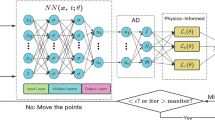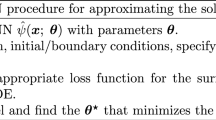Abstract
Soliton solution of Benjamin–Ono (BO) equation has considerable applications in physical field. In this paper, we utilize the Physics-informed neural networks (PINNs) to solve the soliton solution of the BO equation firstly. However, we discern that the imbalance phenomenon of back-propagated gradients occurs between residual loss and initial values or boundary conditions, which leads to the loss function failing to converge well during model training. In order to overcome the faultiness, we introduce self-adaptive parameters into the loss function in PINNs to balance the effect between different terms in original loss function, namely Gradient Balanced PINNs approach. By comparing the performance of solving BO equation, numerical results showed that the prediction accuracy of improved method has improved significantly and absolute error is reduced by order of magnitude. Finally, relevant results have been exhibited in tables and diagrams, dynamical behaviors and error analysis by employing two methods are revealed in detail.








Similar content being viewed by others
Data availability statement
This manuscript has associated data in a data repository. [Authors’comment: The datasets generated or analyzed during the current study are available from the corresponding author on reasonable request.]
References
Y. LeCun, Y. Bengio, G. Hinton, Deep learning. Nature 521, 436–444 (2015)
N. Yadav, A. Yadav, M. Kumar, et al., An introduction to neural network methods for differential equations, Springer (2015)
Z. Liu, Y. Yang, Q. Cai, Neural network as a function approximator and its application in solving differential equations. Appl. Math. Mech. 40, 237–248 (2019)
J. Han, A. Jentzen, E. Weinan, Solving high-dimensional partial differential equations using deep learning. Proc. Natl. Acad. Sci. 115, 8505–8510 (2018)
M. Dissanayake, N. Phan-Thien, Neural-network-based approximations for solving partial differential equations. Commun. Numer. Methods Eng. 10, 195–201 (1994)
M. Raissi, G.E. Karniadakis, Hidden physics models: Machine learning of nonlinear partial differential equations. J. Comput. Phys. 357, 125–141 (2018)
L. Lu, X. Meng, Z. Mao, G.E. Karniadakis, Deepxde: a deep learning library for solving differential equations. SIAM Rev. 63, 208–228 (2021)
A.G. Baydin, B.A. Pearlmutter, A.A. Radul, J.M. Siskind, Automatic differentiation in machine learning: a survey. J. Marchine Learn. Res. 18, 1–43 (2018)
M. Raissi, P. Perdikaris, G.E. Karniadakis, Physics-informed neural networks: a deep learning framework for solving forward and inverse problems involving nonlinear partial differential equations. J. Comput. Phys. 378, 686–707 (2019)
S. Wang, H. Zhang, X. Jiang, Fractional physics-informed neural networks for timefractional phase field models (2021)
L. Yang, D. Zhang, G.E. Karniadakis, Physics-informed generative adversarial networks for stochastic differential equations. SIAM J. Sci. Comput. 42, A292–A317 (2020)
D. Zhang, L. Guo, G.E. Karniadakis, Learning in modal space: Solving time-dependent stochastic pdes using physics-informed neural networks. SIAM J. Sci. Comput. 42, A639–A665 (2020)
G. Pang, L. Lu, G.E. Karniadakis, fpinns: Fractional physics-informed neural networks. SIAM J. Sci. Comput. 41, A2603–A2626 (2019)
E. Haghighat, M. Raissi, A. Moure, H. Gomez, R. Juanes, A physics-informed deep learning framework for inversion and surrogate modeling in solid mechanics. Comput. Methods Appl. Mech. Eng. 379, 113741 (2021)
M. Vahab, E. Haghighat, M. Khaleghi, N. Khalili, A Physics-Informed Neural network approach to solution and identification of biharmonic equations of elasticity. J. Eng. Mech. 148(2), 04021154 (2022)
A.D. Jagtap, K. Kawaguchi, G.E. Karniadakis, Locally adaptive activation functions with slope recovery for deep and physics-informed neural networks. Proceed. Royal Soc. A 476, 20200334 (2020)
S. Wang, Y. Teng, P. Perdikaris, Understanding and mitigating gradient flow pathologies in physics-informed neural networks. SIAM J. Sci. Comput. 43, A3055–A3081 (2021)
A.D. Jagtap, E. Kharazmi, G.E. Karniadakis, Conservative physics-informed neural networks on discrete domains for conservation laws: applications to forward and inverse problems. Comput. Methods Appl. Mech. Engrg. 365, 113028 (2020)
A.D. Jagtap, G.E. Karniadakis, Extended Physics-InformedNeuralNetworks (XPINNs): a Generalized Space-Time Domain Decomposition Based Deep Learning Framework for Nonlinear Partial Differential Equations. Commun. Comput. Phys. 28(5), 2002–2041 (2020)
L. Yang, X. Meng, G.E. Karniadakis, B-PINNs: Bayesian physics-informed neural networks for forward and inverse PDE problems with noisy data. J. Comput. Phys. 425, 109913 (2021)
R. Mattey, S. Ghosh, A novel sequential method to train physics informed neural networks for Allen Cahn and Cahn Hilliard equations. Comput. Methods Appl. Mech. Engrg. 390, 114474 (2022)
P.D. Lax, Integrals of nonlinear equations of evolution and solitary waves. Commun. Pure Appl. Math. 21, 467–490 (1968)
T. Gui-zhang, On liouville integrability of zero-curvature equations and the yang hierarchy. J. Phys. A: Math. Gen. 22, 2375 (1989)
J.C. Pu, J. Li, Y. Chen, Soliton, breather, and rogue wave solutions for solving the nonlinear schr odinger equation using a deep learning method with physical constraints. Chin. Phys. B 30(6), 060202 (2021)
L. Wang, Z. Yan, Data-driven rogue waves and parameter discovery in the defocusing nonlinear schrödinger equation with a potential using the PINN deep learning. Phys. Lett. A 404, 127408 (2021)
Y. Fang, G.-Z. Wu, Y.-Y. Wang, C.-Q. Dai, Data-driven femtosecond optical soliton excitations and parameters discovery of the high-order NLSE using the PINN. Nonlinear Dyn. 105(1), 603–616 (2021)
J. Pu, J. Li, Y. Chen, Solving localized wave solutions of the derivative nonlinear schrödinger equation using an improved pinn method. Nonlinear Dyn. 105(2), 1–17 (2021)
J. Li, J. Chen, B. Li, Gradient-optimized physics-informed neural networks (GOPINNs): a deep learning method for solving the complex modified KdV equation. Nonlinear Dyn. 107(1), 781–792 (2022)
Y. Mo, L. Ling, D. Zeng, Data-driven vector soliton solutions of coupled nonlinear schrödinger equation using a deep learning algorithm. Phys. Lett. A 421, 127739 (2022)
Y.S. Kivshar, B.A. Malomed, Dynamics of solitons in nearly integrable systems. Rev. Mod. Phys. 61, 763–915 (1989)
N.J. Zabusky, M.D. Kruskal, Interaction of solitons in a collisionless plasma and the recurrence of initial states. Phys. Rev. Lett. 15, 240–243 (1965)
Z. Chen, M. Segev, D.N. Christodoulides, Optical spatial solitons: historical overview and recent advances. Rep. Prog. Phys. 75, 086401 (2012)
S. Forte, Quantum mechanics and field theory with fractional spin and statistics. Rev. Mod. Phys. 64, 193–236 (1992)
P.D. Drummond, K.V. Kheruntsyan, H. He, Coherent molecular solitons in bose-einstein condensates. Phys. Rev. Lett. 81, 3055–3058 (1998)
C. Markos, J.C. Travers, A. Abdolvand, B.J. Eggleton, O. Bang, Hybrid photonic-crystal fiber. Rev. Mod. Phys. 89, 045003 (2017)
S. Lou, F. Huang, Alice-bob physics: coherent solutions of nonlocal kdv systems. Sci. Rep. 7, 1–11 (2017)
D. David, D. Levi, P. Winternitz, Solitons in shallow seas of variable depth and in marine straits. Stud. Appl. Math. 80, 1–23 (1989)
M. Ablowitz, P. Clarkson, P.A. Clarkson, Solitons, Nonlinear Evolution Equations and Inverse Scattering, vol. 149 (Cambridge University Press, Cambridge, 1991)
R. Hermann, The geometry of non-linear differential equations, Bäcklund transformations, and solitons. (Math Science Press, 1976)
R. Hirota, The Direct Method in Soliton Theory, 155 (Cambridge University Press, Cambridge, 2004)
X. Wang, L. Wang, J. Wei, B. Guo, J. Kang, Rogue waves in the three-level defocusing coupled Maxwell-Bloch equations. Proc. R. Soc. A. 477, 20210585 (2021)
X. Wang, J. Li, L. Wang, J. Kang, Dark-dark solitons, soliton molecules and elastic collisions in the mixed three-level coupled Maxwell-Bloch equations. Phys. Lett. A 432, 128023 (2022)
John, Weiss, M., Tabor, George, Carnevale, The painlevé property for partial differential equations, J. Math. Phys. 24(3) (1983) 522-526
J. Luo, E. Fan, \(\bar{\partial }\)-dressing method for the coupled gerdjikov-ivanov equation. Appl. Math. Lett. 110, 106589 (2020)
J. Xu, E. Fan, Long-time asymptotics for the fokas-lenells equation with decaying initial value problem: without solitons. J. Differen. Equs. 259, 1098–1148 (2015)
W. Peng, J. Pu, Y. Chen, Pinn deep learning method for the chen-lee-liu equation: rogue wave on the periodic background. Commun. Nonlinear Sci. Numer. Simul. 105, 106067 (2021)
T. Benjamin, Brooke, Internal waves of permanent form in fluids of great depth. J. Fluid Mech. 29, 559–592 (1967)
Hiroaki Ono, Algebraic solitary waves in stratified fluids. J. Phys. Soc. Jpn. 39, 1082–1091 (1975)
C.-M. Fang, S.-F. Tian, Y. Feng, J.-H. Dai, On the integrability and riemann theta functions periodic wave solutions of the benjamin ono equation. Nonlinear Dyn. 92, 235–246 (2018)
W. Tan, Z. Dai, Spatiotemporal dynamics of lump solution to the (1+ 1)-dimensional benjamin-ono equation. Nonlinear Dyn. 89, 2723–2728 (2017)
Y.-K. Liu, B. Li, Dynamics of rogue waves on multisoliton background in the benjamin ono equation. Pramana 88, 57 (2017)
S. Singh, K. Sakkaravarthi, K. Murugesan, R. Sakthivel, Benjamin-ono equation: Rogue waves, generalized breathers, soliton bending, fission, and fusion. Europ. Phys. J. Plus 135, 1–17 (2020)
Diederik P. Kingma, Ba. Jimmy, Adam: A method for stochastic optimization. arXiv preprint arXiv:1412.6980 (2014)
Zixue Xiang, Wei Peng, Xiaohu Zheng, Xiaoyu Zhao, Wen Yao, Self-adaptive loss balanced Physics-informed neural networks for the incompressible Navier-Stokes equations, arXiv preprint arXiv:2104.06217 (2021)
Z. Chen, V. Badrinarayanan, C. Y. Lee, A. Rabinovich, Gradnorm: Gradient normalization for adaptive loss balancing in deep multitask networks. In: International Conference on Machine Learning (pp. 794-803). PMLR (2018)
A. A. Heydari, C. A. Thompson, A. Mehmood, Softadapt: Techniques for adaptive loss weighting of neural networks with multi-part loss functions. arXiv preprint arXiv:1912.12355 (2019)
R. Bischof, M. Kraus, Multi-objective loss balancing for physics-informed deep learning. arXiv preprint arXiv:2110.09813 (2021)
L. McClenny, U. Braga-Neto, Self-adaptive physics-informed neural networks using a soft attention mechanism. arXiv preprint arXiv:2009.04544 (2020)
Sifan Wang, Yu. Xinling, Paris Perdikaris, When and why PINNs fail to train: a neural tangent kernel perspective. J. Comput. Phys. 449, 110768 (2022)
Acknowledgements
Project supported by National Natural Science Foundation of China (Grant Nos. 52171251, U2106225), LiaoNing Revitalization Talents Program (XLYC1907014) and the Fundamental Research Funds for the Central Universities (DUT21ZD205).
Author information
Authors and Affiliations
Corresponding author
Ethics declarations
Conflict of interest
The authors declare that they have no conflict of interest.
Rights and permissions
About this article
Cite this article
Yang, X., Wang, Z. Solving Benjamin–Ono equation via gradient balanced PINNs approach. Eur. Phys. J. Plus 137, 864 (2022). https://doi.org/10.1140/epjp/s13360-022-03078-8
Received:
Accepted:
Published:
DOI: https://doi.org/10.1140/epjp/s13360-022-03078-8




